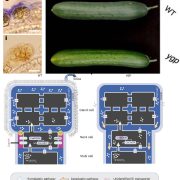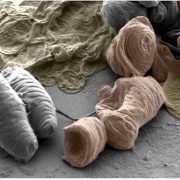Lignin chemistry is fine-tuned on the nanoscale by different combinations of LACCASES
Blaschek et al. explore the spatial control of lignin chemistry.
Leonard Blaschek1 and Edouard Pesquet1,2,3
1 Department of Ecology, Environment and Plant Sciences (DEEP), Stockholm University, 106 91 Stockholm, Sweden
2 Umeå Plant Science Centre (UPSC), Department of Plant Physiology, Umeå University, 901 87 Umeå, Sweden
3 Bolin Centre for Climate Research, Stockholm University, 106 91 Stockholm, Sweden
Background: Lignins are a diverse, complex group of aromatic polymers that accumulate in cell walls of vascular plants, reinforcing organs and enabling long-distance water transport. The different cell wall layers of each cell type exhibit specific lignin chemistries with distinct proportions of specific aromatic substitutions and aliphatic functions. The spatial control of this lignin chemistry was supposed to depend exclusively on the chemical identity of the lignin monomers exported into the cell wall. However, monomer supply alone cannot fully explain the sharp spatial differences between each cell wall layer in the different cell types. We therefore investigated whether different paralogs of the lignin monomer-oxidizing LACCASE enzymes are responsible for spatially controlling lignin chemistry at the cell wall layer level for the different cell types in the vascular tissues of plants.
Question: How are specific lignin chemistries spatially controlled by LACCASE paralogs in each cell wall layer and cell type? What are the roles of LACCASE-dependent lignin accumulation for the mechanical reinforcement and the waterproofing of different cell types in plant vascular tissues?
Findings: We answered these questions by identifying the LACCASE paralogs specifically expressed in vascular cells undergoing lignin accumulation. We analyzed their functions using genetic engineering to switch off five of the six LACCASE paralog genes associated with lignin formation. Their importance in the cell wall layer and cell type lignin accumulation was determined by comparing plants sharing four of the five mutations in different LACCASE paralogs. We show that each LACCASE paralog exhibits specific substrate preference, pH optimum and localization differing between the cell wall layers of each cell type. Their lignin concentration and composition moreover depended on specific combinations of LACCASE paralogs, each enabling different aromatic substitutions and aliphatic functions to accumulate. Impairing these LACCASE-dependent lignin chemistries resulted in the loss of cell wall mechanical resistance of sap-conducting cells and the loss of cell wall waterproofing of organ-reinforcing fiber cells.
Next steps: We are now pursuing research to understand the molecular mechanisms controlling the supply of lignin precursors as well as the temporal regulation activating lignification during the formation/maturation of each cell wall layer in the different cell types.
Reference:
Leonard Blaschek, Emiko Murozuka, Henrik Serk, Delphine Ménard, Edouard Pesquet. (2023). Different combinations of laccase paralogs nonredundantly control the amount and composition of lignin in specific cell types and cell wall layers in Arabidopsis. https://doi.org/10.1093/plcell/koac344








